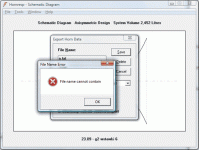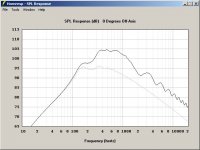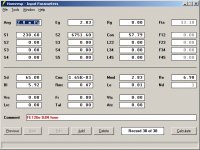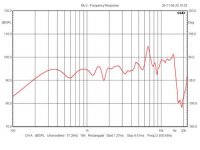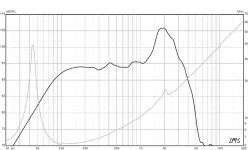Hello Mige0,
The best approach is IMHO the Kirkeby filtering as used by Angelo Farina in his Aurora Plugins.
The linearization must be performed inside a chosen interval of frequency. In such a software as Hornresp it is better to have some automatisation so the limit frequencies inside which the linearization has to be performed have to be automatically estimated.
See an example of the parametering used in Aurora in order for the Kirkeby plug-in.
http://pcfarina.eng.unipr.it/Aurora_XP/immagini/Copia di index_clip_image002.jpg
You should perform a search on Internet with the words:
"Nelson/Kirkeby frequency-domain regularisation"
An example of paper is here:
http://kom.aau.dk/project/navcom/CourseWebSites/InverseFiltering/fp8-26_mm3_note.pdf
Best regards rfom Paris, France
The best approach is IMHO the Kirkeby filtering as used by Angelo Farina in his Aurora Plugins.
The linearization must be performed inside a chosen interval of frequency. In such a software as Hornresp it is better to have some automatisation so the limit frequencies inside which the linearization has to be performed have to be automatically estimated.
See an example of the parametering used in Aurora in order for the Kirkeby plug-in.
http://pcfarina.eng.unipr.it/Aurora_XP/immagini/Copia di index_clip_image002.jpg
You should perform a search on Internet with the words:
"Nelson/Kirkeby frequency-domain regularisation"
An example of paper is here:
http://kom.aau.dk/project/navcom/CourseWebSites/InverseFiltering/fp8-26_mm3_note.pdf
Best regards rfom Paris, France
One thing I miss (or have not focused too much until now) is the possibility to optionally equalize to flat FR before performing a wavelet / spectrogram analysis.
This would highlight the differences in CMP behaviour for different designs even better IMO.
I mean - the most natural thing done until now and being done in the future is to equalize for flat FR (or any house curve of desire), and it might be pretty revealing to have a tool at hand that shows to what extend the results still differ from ideal in the time domain (spectrogram) due to CMP.
Hello Michael,
I think the following paper is a good start:
http://web.uvic.ca/~hgiesbre/499/farina advancements 226-AES122.pdf
the Kirkeby algorithm is described.
Best regards from Paris, France
Jean-Michel Le Cléac'h
I think the following paper is a good start:
http://web.uvic.ca/~hgiesbre/499/farina advancements 226-AES122.pdf
the Kirkeby algorithm is described.
Best regards from Paris, France
Jean-Michel Le Cléac'h
There is a problem with exporting data from hornresp at Schematic diagram / export horn data / horn cross-section dimensions on option other than Con (Exp and Uni).
Hi witasso,
Thanks for the feedback. I have not been able to generate the error message you are seeing - the functionality works fine for me. Could you please post a screenprint of your Input Parameters window so that I can conduct some further tests using the same data as you.
Do you have the latest release of Hornresp, Product Number 2800-100918?
Kind regards,
David
I have not been able to generate the error message you are seeing.
Hi witasso,
On further testing I have found that I can generate the same error as you, under some conditions.
I will let you know when the bug is fixed.
Kind regards,
David
Hello,
I was always wondering why they name it 'Kirkeby method' since it's a straight Wiener-Kolmogorov deconvolution, known for 70 about years??
- Elias
I was always wondering why they name it 'Kirkeby method' since it's a straight Wiener-Kolmogorov deconvolution, known for 70 about years??
- Elias
The best approach is IMHO the Kirkeby filtering as used by Angelo Farina in his Aurora Plugins.
The linearization must be performed inside a chosen interval of frequency. In such a software as Hornresp it is better to have some automatisation so the limit frequencies inside which the linearization has to be performed have to be automatically estimated.
See an example of the parametering used in Aurora in order for the Kirkeby plug-in.
http://pcfarina.eng.unipr.it/Aurora_XP/immagini/Copia di index_clip_image002.jpg
You should perform a search on Internet with the words:
"Nelson/Kirkeby frequency-domain regularisation"
An example of paper is here:
http://kom.aau.dk/project/navcom/CourseWebSites/InverseFiltering/fp8-26_mm3_note.pdf
Best regards rfom Paris, France
Hornresp Bug Fix
Hi witasso,
Hopefully the bug you found has now been fixed. The latest Hornresp release is Product Number 2800-100929.
Thanks again for the feedback.
Kind regards,
David
I will let you know when the bug is fixed.
Hi witasso,
Hopefully the bug you found has now been fixed. The latest Hornresp release is Product Number 2800-100929.
Thanks again for the feedback.
Kind regards,
David
Hi All, I am here asking for help...nay, begging for help. I have a new pair of speakers that are neither fish nor fowl. I have some ideas of what direction to take them but I am just plain stupid when it comes to computer programs and in particular Hornresp.
Here are pix of the speakers. They are large horns with a Fostex FE126e driver in them. They run full range with the Alpha 15a woofs in "H" frames. They actually sound very nice. Open, detailed, live, but from 200hz (where the 126e kicks in) to around 3.5khz the signal is much lower in volume than above 3.5khz, where it REALLY kicks in.
I don't know is this is a result of the horn design or the driver. I do know the 126e has a fairly substantial peak in the higher freqs.
My options are to find a better, flatter driver like the Mark Audio Alpair7, or, turn these into true midbass horns by whacking the back plate off and putting a 10 or 12 or 15" driver back there with the proper compression ratio.
Before I do that though, I figure I show know what these will do as a horn modeled in HornResp.
They are conical flairs with open baffle
The mouth is 22.75" wide by 46" tall.
They are 22.75" straight line deep
The throat (without the back plate) is 6.5" wide by 5.5" tall.
I know this is a subwoofer forum, but can one of fine gentleman help me figure out what to do with these. Thanks in advance......much appreciated.
Here are pix of the speakers. They are large horns with a Fostex FE126e driver in them. They run full range with the Alpha 15a woofs in "H" frames. They actually sound very nice. Open, detailed, live, but from 200hz (where the 126e kicks in) to around 3.5khz the signal is much lower in volume than above 3.5khz, where it REALLY kicks in.
I don't know is this is a result of the horn design or the driver. I do know the 126e has a fairly substantial peak in the higher freqs.
My options are to find a better, flatter driver like the Mark Audio Alpair7, or, turn these into true midbass horns by whacking the back plate off and putting a 10 or 12 or 15" driver back there with the proper compression ratio.
Before I do that though, I figure I show know what these will do as a horn modeled in HornResp.
They are conical flairs with open baffle
The mouth is 22.75" wide by 46" tall.
They are 22.75" straight line deep
The throat (without the back plate) is 6.5" wide by 5.5" tall.
I know this is a subwoofer forum, but can one of fine gentleman help me figure out what to do with these. Thanks in advance......much appreciated.
Attachments
I did a quick model in hornresp, and it looks like you should get strong response from ~1kHz down to 300Hz on axis with the highs rolling off. Since this is not matching the results you're getting, I'd say the issue is the high frequency response of the speaker. I attached screen shots. The dark curve is on-axis, the lighter lower curve is constant directivity (power response).
I'd try applying eq and seeing if you can get the tonal balance to be what you want before you start swapping drivers. I'm not saying that is a final solution, but if you can't get the tonal balance right with this horn and this size driver in it, changing drivers won't make a big difference - they'd just change the eq you needed to apply to get to a given frequency response curve.
Edit - to expand on that a bit, if you can't get the horn to sound right tonally as is with eq, that could be because of the polar pattern. So if you change the driver for a new one that's the same size, then you won't be likely to change the polar pattern very much and thus the issue won't go away. What would more likely change is the frequency response without eq. Thus my suggestion to try the eq first. If the system sounds tonally right with the eq but you don't want to have the eq in there, then you could look for a different driver.
I'd try applying eq and seeing if you can get the tonal balance to be what you want before you start swapping drivers. I'm not saying that is a final solution, but if you can't get the tonal balance right with this horn and this size driver in it, changing drivers won't make a big difference - they'd just change the eq you needed to apply to get to a given frequency response curve.
Edit - to expand on that a bit, if you can't get the horn to sound right tonally as is with eq, that could be because of the polar pattern. So if you change the driver for a new one that's the same size, then you won't be likely to change the polar pattern very much and thus the issue won't go away. What would more likely change is the frequency response without eq. Thus my suggestion to try the eq first. If the system sounds tonally right with the eq but you don't want to have the eq in there, then you could look for a different driver.
Attachments
Last edited:
Thanks John. Yep, I am not hearing that plot at all. Almost like the reverse of it. I agree with your assesment that if the geometry is bad, then a great driver will not make a difference.
I don't know if you can do this or I should say, if HR can do this, but if I used the 6.5" x 5.6" back (removed) then stuck a 12" (or what ever size driver would make a 2:1 compression ration) on the back with a back chamber would it work as a midbass horn better than full range OB/horn.
Thanks again.....that reverse of what I am hearing plot stumps me.
Edit: I wonder if I put a back chamber around the driver if it would change things much.
I don't know if you can do this or I should say, if HR can do this, but if I used the 6.5" x 5.6" back (removed) then stuck a 12" (or what ever size driver would make a 2:1 compression ration) on the back with a back chamber would it work as a midbass horn better than full range OB/horn.
Thanks again.....that reverse of what I am hearing plot stumps me.
Edit: I wonder if I put a back chamber around the driver if it would change things much.
Hornresp doesn't account for cone breakup, so it's not completely unexpected that the results don't match exactly in cases like this. However typically you use a horn like this to bring up the low end of a fullrange driver to match the higher level of the cone breakup, so it's weird that you aren't hearing that to some extent.
I suppose it depends on your definition of midbass, but I doubt you'd get it to go any lower than it does now. So it could potentially be a lower midrange horn with another driver but I'll leave that modeling to someone else.
I suppose it depends on your definition of midbass, but I doubt you'd get it to go any lower than it does now. So it could potentially be a lower midrange horn with another driver but I'll leave that modeling to someone else.
Thanks John. Using a tone generator I match up the mid bass (200hz on up) to the "H" frame and I get a very smooth transition in that region, but when I step through the tones, at 3.5khz on up they scream. That being said, I can't really tell how the midbass sounds in the music. I don't have an eq to play with either. I can tell you that from 3.5khz on up sounds great. Clear, clean, fast, and with gret detail. It is just way out of whack.
Thanks for your help.
Thanks for your help.
Another question. I modeled the horn with a 12" driver and for the most part got the same looking plot that John got when he modeled it with the FE126E.
So, my question is this: when it shows a upper end roll off why, in practice, do the highs still come through so strong and clean? (the highs go on way after the highend roll off shown in the HR plot.
So, my question is this: when it shows a upper end roll off why, in practice, do the highs still come through so strong and clean? (the highs go on way after the highend roll off shown in the HR plot.
You're welcome!
FWIW, for such apps, I use ~1 WL of its axial length as a good point to XO at or ~600 Hz for this horn which in this case pushes it high enough to put the highest power transients on the (mid) woofer. Combined with a 2nd order XO, the 15a's break-up modes will be flattened considerably to help boost overall performance, but my SWAG is that you'll either have to shelve the 126 or add a second 15a to pump up its efficiency.
WRT the 126, the lone measured response I have shows it to be a bit of a screamer with a single ear splitting spike up in our sibilance BW where it makes my teeth hurt, so it would seem that either listening as far off axis as the horn walls allow and/or EQing it would be worth a try. That, or make an expo horn to pump up the driver's lower response and choke down its HF somewhat. In any case, finding where that spike's coming from and damping it mechanically would be the #1 priority if it were mine.
GM
FWIW, for such apps, I use ~1 WL of its axial length as a good point to XO at or ~600 Hz for this horn which in this case pushes it high enough to put the highest power transients on the (mid) woofer. Combined with a 2nd order XO, the 15a's break-up modes will be flattened considerably to help boost overall performance, but my SWAG is that you'll either have to shelve the 126 or add a second 15a to pump up its efficiency.
WRT the 126, the lone measured response I have shows it to be a bit of a screamer with a single ear splitting spike up in our sibilance BW where it makes my teeth hurt, so it would seem that either listening as far off axis as the horn walls allow and/or EQing it would be worth a try. That, or make an expo horn to pump up the driver's lower response and choke down its HF somewhat. In any case, finding where that spike's coming from and damping it mechanically would be the #1 priority if it were mine.
GM
Attachments
Thanks for your thoughts GM. Yep, it is that peak and the general rise after 3.5khz that is the problem. The more I work with this horn, again, that I like very much, the more I think that I need to 1. find a driver that is more suited for this app or 2. figure out a step down for 3.5khz and above, or 3. whack off the back of the horns, attach a 12" woof and call it a true midbass horn. I have a number of tractrix horns that will so up from 600 - 800hz on up.
The other thing I thought about last night was to take the horn off the stand and drop the bottom lip down to the floor to pick up some re-enforcement of the floor.
I am bi-amping so I can bring up the woof seperatly. But are you saying that I should cross the 126 and 15a at 600hz? I have all the bits to do that, and think it would work given the 15a plot...below.
I have been a horn guy for the last 30 years and this is my first OB system. Maybe it is my age, but I really like the OB.
The other thing I thought about last night was to take the horn off the stand and drop the bottom lip down to the floor to pick up some re-enforcement of the floor.
I am bi-amping so I can bring up the woof seperatly. But are you saying that I should cross the 126 and 15a at 600hz? I have all the bits to do that, and think it would work given the 15a plot...below.
I have been a horn guy for the last 30 years and this is my first OB system. Maybe it is my age, but I really like the OB.
Attachments
- Home
- Loudspeakers
- Subwoofers
- Hornresp
